One Hundred Years of V(λ): Predicting Spatial Brightness Using Vertical Illuminance Derived from Photopic Luminous Efficiency Functions
Abstract
1. Introduction
2. Background
2.1. Photopic Luminous Efficiency Functions
2.2. Spatial Brightness
3. Methods
3.1. Apparatus
3.2. Stimuli
- Three pairs of V10(λ) vs. V(λ): Pair 1 at 50 lx, Pair 2 at 100 lx, Pair 3 at 300 lx.
- Three pairs of VF(λ) vs. V(λ): Pair 1 at 50 lx, Pair 2 at 100 lx, Pair 3 at 300 lx.
- Three pairs of VF,10(λ) vs. V(λ): Pair 1 at 50 lx, Pair 2 at 100 lx, Pair 3 at 300 lx.
- One pair of null conditions.
- Three pairs of V10(λ) vs. V(λ): Pair 1 at 50 lx, Pair 2 at 100 lx, Pair 3 at 300 lx.
- Three pairs of VF(λ) vs. V(λ): Pair 1 at 50 lx, Pair 2 at 100 lx, Pair 3 at 300 lx.
- Three pairs of VF,10(λ) vs. V(λ): Pair 1 at 50 lx, Pair 2 at 100 lx, Pair 3 at 300 lx.
- One pair of null conditions.
- Three pairs of V10(λ) vs. V(λ): Pair 1 at 50 lx, Pair 2 at 100 lx, Pair 3 at 300 lx.
- Three pairs of VF(λ) vs. V(λ): Pair 1 at 50 lx, Pair 2 at 100 lx, Pair 3 at 300 lx.
- Three pairs of VF,10(λ) vs. V(λ): Pair 1 at 50 lx, Pair 2 at 100 lx, Pair 3 at 300 lx.
- One pair of null conditions.
3.3. Participants
3.4. Experimental Protocol
3.5. Statistical Methods
4. Results
5. Discussion
6. Conclusions
Author Contributions
Funding
Data Availability Statement
Acknowledgments
Conflicts of Interest
References
- Ohno, Y. Photometry. In Handbook of Visual Optics, Volume One; Taylor & Francis: Abingdon, UK, 2017. [Google Scholar]
- CIE. CIE Proceedings. In Proceedings of the Commission Internationale de l’Eclairage Compte Rendu des Séances, Sixiéme Sessio; Cambridge University Press: Cambridge, UK, 1924. [Google Scholar]
- Coblentz, W.W.; Emerson, W.B. Relative Sensibility of the Average Eye to Light of Different Colors and Some Practical Applications to Radiation Problems; Bulletin of the Bureau of Standards; U.S. Department of Commerce, Bureau of Standards: Washington, DC, USA, 1918; Volume 14. [Google Scholar]
- Hartman, L. The Visibility of Radiation in the Blue End of the Visible Spectrum. Astrophys. J. 1918, 47, 83. [Google Scholar] [CrossRef]
- Hyde, E.; Forsythe, W.; Cady, F. The Visibility of Radiation. Astrophys. J. 1918, 48, 65. [Google Scholar] [CrossRef]
- Gibson, K.S.; Tyndall, E.P.T. Visibility of Radiant Energy; US Government Printing Office: Washington, DC, USA, 1923; Volume 19. [Google Scholar]
- Judd, D.B. Color in Business, Science and Industry; Wiley: New York, NY, USA, 1952. [Google Scholar]
- Comerford, J.P.; Kaiser, P.K. Luminous-Efficiency Functions Determined by Heterochromatic Brightness Matching. J. Opt. Soc. Am. 1975, 65, 466–468. [Google Scholar] [CrossRef]
- Vos, J.J. Colorimetric and Photometric Properties of a 2° Fundamental Observer. Color Res. Appl. 1978, 3, 125–128. [Google Scholar] [CrossRef]
- Sagawa, K.; Takahashi, Y. Spectral Luminous Efficiency as a Function of Age. J. Opt. Soc. Am. A 2001, 18, 2659–2667. [Google Scholar] [CrossRef]
- Sharpe, L.T.; Stockman, A.; Jagla, W.; Jägle, H. A Luminous Efficiency Function, VD65* (λ), for Daylight Adaptation: A Correction. Color Res. Appl. 2011, 36, 42–46. [Google Scholar] [CrossRef]
- Wyszecki, G.; Stiles, W.S. Color Science: Concepts and Methods, Quantitative Data, and Formulae; Wiley Classics Library; Wiley Classics Library, Ed.; John Wiley & Sons: New York, NY, USA, 2000; ISBN 978-0-471-39918-6. [Google Scholar]
- Schanda, J. Colorimetry: Understanding the CIE System; John Wiley & Sons: Hoboken, NJ, USA, 2007; ISBN 0-470-17562-1. [Google Scholar]
- Stockman, A. Cone Fundamentals and CIE Standards. Curr. Opin. Behav. Sci. 2019, 30, 87–93. [Google Scholar] [CrossRef]
- Sharpe, L.T.; Stockman, A.; Jagla, W.; Jägle, H. A Luminous Efficiency Function, V*(λ), for Daylight Adaptation. J. Vis. 2005, 5, 3. [Google Scholar] [CrossRef]
- Song, W.; Durmus, D. Evaluating Energy Efficiency and Colorimetric Quality of Electric Light Sources Using Alternative Spectral Sensitivity Functions. Buildings 2022, 12, 2220. [Google Scholar] [CrossRef]
- Song, W.; Durmus, D. Evaluating Energy Efficiency and Color Quality of LEDs Using Alternative Spectral Sensitivity Functions. In Proceedings of the Optica Advanced Photonics Congress 2022, Maastricht, The Netherlands, 24–28 July 2022; Optica Publishing Group: Washington, DC, USA, 2022; p. PvM3H.2. [Google Scholar]
- Duff, J.; Kelly, K.; Cuttle, C. Spatial Brightness, Horizontal Illuminance and Mean Room Surface Exitance in a Lighting Booth. Light. Res. Technol. 2017, 49, 5–15. [Google Scholar] [CrossRef]
- Fotios, S.A. Lamp Colour Properties and Apparent Brightness: A Review. Light. Res. Technol. 2001, 33, 163–178. [Google Scholar] [CrossRef]
- Stevens, S.S. Duration, Luminance, and the Brightness Exponent. Percept. Psychophys. 1966, 1, 96–100. [Google Scholar] [CrossRef]
- Bernecker, C.A.; Mier, J.M. The Effect of Source Luminance on the Perception of Environment Brightness. J. Illum. Eng. Soc. 1985, 15, 253–271. [Google Scholar] [CrossRef]
- Arend, L.E.; Spehar, B. Lightness, Brightness, and Brightness Contrast: 1. Illuminance Variation. Percept. Psychophys. 1993, 54, 446–456. [Google Scholar] [CrossRef]
- Hermans, S.; Smet, K.A.G.; Hanselaer, P. Brightness Model for Neutral Self-Luminous Stimuli and Backgrounds. Leukos 2018, 14, 231–244. [Google Scholar] [CrossRef]
- Yu, H.; Ko, B.; Koga, T.; Hirate, K.; Suzuki, N. Validation of the Predictive Equation for Spatial Brightness in an Experimental Space. Archit. Sci. Rev. 2019, 62, 493–506. [Google Scholar] [CrossRef]
- CIE 212:2014; Guidance Towards Best Practice in Psychophysical Procedures Used When Measuring Relative Spatial Brightness. Commission Internationale de l’Eclairage: Vienna, Austria, 2014.
- CIE 165:2005; CIE 10 Degree Photopic Photometric Observer. Publication/CIE; CIE Central Bureau: Vienna, Austria, 2005; ISBN 978-3-901906-39-8.
- Ishak, I.G.H. The Photopic Luminosity Curve for a Group of Fifteen Egyptian Trichromats. J. Opt. Soc. Am. 1952, 42, 529. [Google Scholar] [CrossRef]
- Adams, C.K.; Dawson, W.W. Fast Retinal Potential Luminosity Functions. Vis. Res. 1971, 11, 1135–1146. [Google Scholar] [CrossRef]
- Bornstein, M.H.; Marks, L.E. Photopic Luminosity Measured by the Method of Critical Frequency. Vis. Res. 1972, 12, 2023–2033. [Google Scholar] [CrossRef]
- Rovamo, J.; Koljonen, T.; Näsänen, R. A New Psychophysical Method for Determining the Photopic Spectral-Luminosity Function of the Human Eye. Vis. Res. 1996, 36, 2675–2680. [Google Scholar] [CrossRef]
- CIE 075-1988; Spectral Luminous Efficiency Functions Based upon Heterochromatic Brightness Matching for Monochromatic Point Sources, 2° and 10° Fields. Commission Internationale de l’Eclairage: Vienna, Austria, 1988.
- Dresler, A. The Non-Additivity of Heterochromatic Brightnesses. Trans. Illum. Eng. Soc. 1953, 18, 141–165. [Google Scholar] [CrossRef]
- Guth, S.L.; Lodge, H.R. Heterochromatic Additivity, Foveal Spectral Sensitivity, and a New Color Model. J. Opt. Soc. Am. 1973, 63, 450. [Google Scholar] [CrossRef]
- Kaiser, P.K.; Wyszecki, G. Additivity Failures in Heterochromatic Brightness Matching. Color Res. Appl. 1978, 3, 177–182. [Google Scholar] [CrossRef]
- Abney, W.D.W. VII. The Sensitiveness of the Retina to Light and Colour. Phil. Trans. R. Soc. Lond. A 1897, 190, 155–195. [Google Scholar] [CrossRef]
- Boynton, R.M.; Kaiser, P.K. Vision: The Additivity Law Made to Work for Heterochromatic Photometry with Bipartite Fields. Science 1968, 161, 366–368. [Google Scholar] [CrossRef] [PubMed]
- Nimeroff, I. Colorimetry in Parafoveal Fields* I Color-Matching Functions. J. Opt. Soc. Am. 1964, 54, 824. [Google Scholar] [CrossRef]
- Pokorny, J.; Smith, V.C.; Xu, J. Quantal and Non-Quantal Color Matches: Failure of Grassmann’s Laws at Short Wavelengths. J. Opt. Soc. Am. A 2012, 29, A324. [Google Scholar] [CrossRef] [PubMed]
- Yaguchi, H.; Ikeda, M. Subadditivity and Superadditivity in Heterochromatic Brightness Matching. Vis. Res. 1983, 23, 1711–1718. [Google Scholar] [CrossRef]
- Nakano, Y.; Ikeda, M.; Kaiser, P.K. Contributions of the Opponent Mechanisms to Brightness and Nonlinear Models. Vis. Res. 1988, 28, 799–810. [Google Scholar] [CrossRef] [PubMed]
- Nayatani, Y.; Sobagaki, H. Prediction of Experimental Results on Additivity-Law Failure. Color Res. Appl. 2000, 25, 32–42. [Google Scholar] [CrossRef]
- Nayatani, Y.; Sobagaki, H. Relationship between Brightness/Luminance Ratio and Additivity-law Failure. Color Res. Appl. 2002, 27, 185–190. [Google Scholar] [CrossRef]
- Davidson, M. Perturbation Approach to Spatial Brightness Interaction in Human Vision. J. Opt. Soc. Am. 1968, 58, 1300. [Google Scholar] [CrossRef]
- Fotios, S.; Atli, D. Comparing Judgments of Visual Clarity and Spatial Brightness through an Analysis of Studies Using the Category Rating Procedure. Leukos 2012, 8, 261–281. [Google Scholar]
- Ju, J.; Chen, D.; Lin, Y. Effects of Correlated Color Temperature on Spatial Brightness Perception. Color Res. Appl. 2012, 37, 450–454. [Google Scholar] [CrossRef]
- Harrington, R.E. Effect of Color Temperature on Apparent Brightness. J. Opt. Soc. Am. 1954, 44, 113. [Google Scholar] [CrossRef]
- Burns, S.A.; Smith, V.C.; Pokorny, J.; Elsner, A.E. Brightness of Equal-Luminance Lights. J. Opt. Soc. Am. 1982, 72, 1225. [Google Scholar] [CrossRef]
- Berman, S.M.; Jewett, D.L.; Fein, G.; Saika, G.; Ashford, F. Photopic Luminance Does Not Always Predict Perceived Room Brightness. Light. Res. Technol. 1990, 22, 37–41. [Google Scholar] [CrossRef]
- Gooley, J.J.; Lu, J.; Chou, T.C.; Scammell, T.E.; Saper, C.B. Melanopsin in Cells of Origin of the Retinohypothalamic Tract. Nat. Neurosci. 2001, 4, 1165. [Google Scholar] [CrossRef]
- Berman, S.M. Energy Efficiency Consequences of Scotopic Sensitivity. J. Illum. Eng. Soc. 1992, 21, 3–14. [Google Scholar] [CrossRef]
- Berman, S.M.; Jewett, D.L.; Benson, B.R.; Law, T.M. Despite Different Wall Colors, Vertical Scotopic Illuminance Predicts Pupil Size. J. Illum. Eng. Soc. 1997, 26, 59–68. [Google Scholar] [CrossRef]
- Berson, D.M.; Dunn, F.A.; Takao, M. Phototransduction by Retinal Ganglion Cells That Set the Circadian Clock. Science 2002, 295, 1070–1073. [Google Scholar] [CrossRef]
- Bowmaker, J.K.; Dartnall, H.J. Visual Pigments of Rods and Cones in a Human Retina. J. Physiol. 1980, 298, 501–511. [Google Scholar] [CrossRef]
- Berman, S.M. A New Retinal Photoreceptor Should Affect Lighting Practice. Light. Res. Technol. 2008, 40, 373–376. [Google Scholar] [CrossRef]
- Brown, T.M.; Tsujimura, S.; Allen, A.E.; Wynne, J.; Bedford, R.; Vickery, G.; Vugler, A.; Lucas, R.J. Melanopsin-Based Brightness Discrimination in Mice and Humans. Curr. Biol. 2012, 22, 1134–1141. [Google Scholar] [CrossRef]
- Zele, A.J.; Adhikari, P.; Feigl, B.; Cao, D. Cone and Melanopsin Contributions to Human Brightness Estimation. J. Opt. Soc. Am. A 2018, 35, B19–B25. [Google Scholar] [CrossRef]
- Spitschan, M. Melanopsin Contributions to Non-Visual and Visual Function. Curr. Opin. Behav. Sci. 2019, 30, 67–72. [Google Scholar] [CrossRef]
- Yamakawa, M.; Tsujimura, S.; Okajima, K. A Quantitative Analysis of the Contribution of Melanopsin to Brightness Perception. Sci. Rep. 2019, 9, 7568. [Google Scholar] [CrossRef]
- DeLawyer, T.; Tsujimura, S.; Shinomori, K. Relative Contributions of Melanopsin to Brightness Discrimination When Hue and Luminance Also Vary. J. Opt. Soc. Am. A 2020, 37, A81. [Google Scholar] [CrossRef]
- Hu, Z.; Zhang, P.; Huang, Y.; Li, M.; Dai, Q. The Impact of Melanopic Illuminance and CCT on Spatial Brightness Perception of Illuminated Interiors and Energy-Saving Implications. Build. Environ. 2022, 223, 109524. [Google Scholar] [CrossRef]
- Khanh, T.Q.; Bodrogi, P.; Zandi, B.; Vinh, T.Q. Brightness Perception under Photopic Conditions: Experiments and Modeling with Contributions of S-Cone and IpRGC. Sci. Rep. 2023, 13, 14542. [Google Scholar] [CrossRef]
- Tikidji-Hamburyan, A.; Reinhard, K.; Storchi, R.; Dietter, J.; Seitter, H.; Davis, K.E.; Idrees, S.; Mutter, M.; Walmsley, L.; Bedford, R.A.; et al. Rods Progressively Escape Saturation to Drive Visual Responses in Daylight Conditions. Nat. Commun. 2017, 8, 1813. [Google Scholar] [CrossRef]
- Zele, A.J.; Dey, A.; Adhikari, P.; Feigl, B. Rhodopsin and Melanopsin Contributions to Human Brightness Estimation. J. Opt. Soc. Am. A 2020, 37, A145. [Google Scholar] [CrossRef]
- Frederiksen, R.; Morshedian, A.; Tripathy, S.A.; Xu, T.; Travis, G.H.; Fain, G.L.; Sampath, A.P. Rod Photoreceptors Avoid Saturation in Bright Light by the Movement of the G Protein Transducin. J. Neurosci. 2021, 41, 3320–3330. [Google Scholar] [CrossRef]
- Royer, M.P.; Houser, K.W. Spatial Brightness Perception of Trichromatic Stimuli. Leukos 2012, 9, 89–108. [Google Scholar] [CrossRef]
- Mahmoudzadeh, P.; Hu, W.; Davis, W.; Durmus, D. The Effect of Center and Surround Luminance, Visual Angle, Edge Blur, and Contrast Polarity on Overall Brightness Perception. Build. Environ. 2025, 271, 112582. [Google Scholar] [CrossRef]
- Besenecker, U.; Bullough, J.; Radetsky, L. Spectral Sensitivity and Scene Brightness at Low to Moderate Photopic Light Levels. Light. Res. Technol. 2016, 48, 676–688. [Google Scholar] [CrossRef]
- Bullough, J.D.; Radetsky, L.C.; Besenecker, U.C.; Rea, M.S. Influence of Spectral Power Distribution on Scene Brightness at Different Light Levels. Leukos 2014, 10, 3–9. [Google Scholar] [CrossRef]
- Rea, M.; Mou, X.; Bullough, J. Scene Brightness of Illuminated Interiors. Light. Res. Technol. 2016, 48, 823–831. [Google Scholar] [CrossRef]
- Rea, M.; Radetsky, L.; Bullough, J. Toward a Model of Outdoor Lighting Scene Brightness. Light. Res. Technol. 2011, 43, 7–30. [Google Scholar] [CrossRef]
- Besenecker, U.; Bullough, J. Investigating Visual Mechanisms Underlying Scene Brightness. Light. Res. Technol. 2017, 49, 16–32. [Google Scholar] [CrossRef]
- DeLaney, W.B.; Hughes, P.C.; McNelis, J.F.; Sarver, J.F.; Soules, T.F. An Examination of Visual Clarity with High Color Rendering Fluorescent Light Sources. J. Illum. Eng. Soc. 1978, 7, 74–84. [Google Scholar] [CrossRef]
- Flynn, J.E.; Spencer, T.J. The Effects of Light Source Color on User Impression and Satisfaction. J. Illum. Eng. Soc. 1977, 6, 167–179. [Google Scholar] [CrossRef]
- Boyce, P.R.; Cuttle, C. Effect of Correlated Colour Temperature on the Perception of Interiors and Colour Discrimination Performance. Light. Res. Technol. 1990, 22, 19–36. [Google Scholar] [CrossRef]
- Vrabel, P.L.; Bernecker, C.A.; Mistrick, R.G. Visual Performance and Visual Clarity under Electric Light Sources: Part II—Visual Clarity. J. Illum. Eng. Soc. 1998, 27, 29–41. [Google Scholar] [CrossRef]
- Manav, B. An Experimental Study on the Appraisal of the Visual Environment at Offices in Relation to Colour Temperature and Illuminance. Build. Environ. 2007, 42, 979–983. [Google Scholar] [CrossRef]
- Vienot, F.; Durand, M.-L.; Mahler, E. Kruithof’s Rule Revisited Using LED Illumination. J. Mod. Opt. 2009, 56, 1433–1446. [Google Scholar] [CrossRef]
- Barraza, J.F.; Martín, A. The Effect of Texture on Brightness Perception in Simulated Scenes. Leukos 2020, 16, 279–287. [Google Scholar] [CrossRef]
- Festinger, L.; Coren, S.; Rivers, G. The Effect of Attention on Brightness Contrast and Assimilation. Am. J. Psychol. 1970, 83, 189. [Google Scholar] [CrossRef]
- Komatsu, H.; Murakami, I.; Kinoshita, M. Surface Representation in the Visual System. Cogn. Brain Res. 1996, 5, 97–104. [Google Scholar] [CrossRef]
- Issolio, L.; Colombo, E.M. Brightness for Different Surround Conditions: The Effect of Transient Glare. Percept. Psychophys. 2006, 68, 702–709. [Google Scholar] [CrossRef]
- ANSI/IES RP-11-20; Recommended Practice: Lighting for Interior and Exterior Residential Environments. IES: New York, NY, USA, 2020.
- ANSI/IES RP-10-20; Recommended Practice: Lighting Common Applications. IES: New York, NY, USA, 2020.
- Ohno, Y. Practical Use and Calculation of CCT and Duv. Leukos 2014, 10, 47–55. [Google Scholar] [CrossRef]
- Durmus, D. Correlated Color Temperature: Use and Limitations. Light. Res. Technol. 2022, 54, 363–375. [Google Scholar] [CrossRef]
- Fotios, S.; Houser, K.; Cheal, C. Counterbalancing Needed to Avoid Bias in Side-by-Side Brightness Matching Tasks. Leukos 2008, 4, 207–223. [Google Scholar] [CrossRef]
- Faul, F.; Erdfelder, E.; Lang, A.-G.; Buchner, A. G*Power 3: A Flexible Statistical Power Analysis Program for the Social, Behavioral, and Biomedical Sciences. Behav. Res. Methods 2007, 39, 175–191. [Google Scholar] [CrossRef]
- Zihl, J.; Pöppel, E.; Von Cramon, D. Diurnal Variation of Visual Field Size in Patients with Postretinal Lesions. Exp. Brain Res. 1977, 27, 245–249. [Google Scholar] [CrossRef]
- Zhang, Y.; Tu, Y.; Wang, L.; Shi, Y. Effects of Blue-Enriched White Light with Same Correlated Colour Temperature on Visual Fatigue. Light. Res. Technol. 2024, 56, 381–402. [Google Scholar] [CrossRef]
- Fotios, S.A.; Houser, K.W. Using Forced Choice Discrimination to Measure the Perceptual Response to Light of Different Characteristics. Leukos 2013, 9, 245–259. [Google Scholar] [CrossRef]
- Royer, M.; Houser, K.; Durmus, D.; Esposito, T.; Wei, M. Recommended Methods for Conducting Human Factors Experiments on the Subjective Evaluation of Colour Rendition. Light. Res. Technol. 2022, 54, 199–236. [Google Scholar] [CrossRef]
- Spitschan, M. Photoreceptor Inputs to Pupil Control. J. Vis. 2019, 19, 5. [Google Scholar] [CrossRef]
- Legras, R.; Gaudric, A.; Woog, K. Distribution of Cone Density, Spacing and Arrangement in Adult Healthy Retinas with Adaptive Optics Flood Illumination. PLoS ONE 2018, 13, e0191141. [Google Scholar] [CrossRef]
- Sagawa, K.; Takeichi, K. Spectral Luminous Efficiency Functions for a Ten-Degree Field in the Mesopic Range. J. Light Vis. Environ. 1983, 7, 37–44. [Google Scholar] [CrossRef]
- Schanda, J.; Morren, L.; Rea, M.; Rositani-Ronchi, L.; Walraven, P. Does Lighting Need More Photopic Luminous Efficiency Functions? Light. Res. Technol. 2002, 34, 69–76. [Google Scholar] [CrossRef]
- Fan, S.; Zhang, X.; Gu, X.; Shen, H.; Liu, M. Influence of Pulse Width on Luminous Efficiency for a Two-Degree Field. Light. Res. Technol. 2017, 49, 357–369. [Google Scholar] [CrossRef]
- Li, J.; Ohno, Y. Characterizing the Accuracy of the Current CIE-Standard and Cone-Fundamental-Based Spectral Luminous Efficiency Functions Based on Achromatic Brightness Matches. In Proceedings of the 2024 IEEE Sustainable Smart Lighting World Conference & Expo (LS24), Eindhoven, The Netherlands, 12 November 2024; pp. 1–4. [Google Scholar]
- Palmer, D.A. Standard Observer for Large-Field Photometry at Any Level. J. Opt. Soc. Am. 1968, 58, 1296. [Google Scholar] [CrossRef] [PubMed]
- Chapiro, A.; Kunkel, T.; Atkins, R.; Daly, S. Influence of Screen Size and Field of View on Perceived Brightness. ACM Trans. Appl. Percept. 2018, 15, 1–13. [Google Scholar] [CrossRef]
- Lim, K.; Li, X.; Tu, Y. Dependence of Perceived Display Brightness on Peripheral Vision Luminance and Field of View: A Comparison Study. J. Soc. Inf. Disp. 2019, 27, 715–722. [Google Scholar] [CrossRef]
- Stevens, S.S. On the Psychophysical Law. Psychol. Rev. 1957, 64, 153. [Google Scholar] [CrossRef]
- Seim, T.; Valberg, A. A Neurophysiologically-based Analysis of Lightness and Brightness Perception. Color Res. Appl. 2016, 41, 339–351. [Google Scholar] [CrossRef]
- Arend, L.E.; Goldstein, R. Simultaneous Constancy, Lightness, and Brightness. J. Opt. Soc. Am. A 1987, 4, 2281–2285. [Google Scholar] [CrossRef]
- Purves, D.; Williams, S.M.; Nundy, S.; Lotto, R.B. Perceiving the Intensity of Light. Psychol. Rev. 2004, 111, 142–158. [Google Scholar] [CrossRef]
- Rosas, E.; Estrada-Hernández, A. Effect of Photometric Detector Spectral Response Quality on White LED Spectral Mismatch Correction Factors. Appl. Opt. 2016, 55, 5267. [Google Scholar] [CrossRef]
- de Vries, A.; Heynderickx, I.; de Kort, Y. From Luminance to Brightness: A Data-Driven Approach to Support Brightness Assessments in Open Plan Offices. Light. Res. Technol. 2022, 54, 798–818. [Google Scholar] [CrossRef]
- Wooten, B.R.; Fuld, K.; Spillmann, L. Photopic Spectral Sensitivity of the Peripheral Retina. J. Opt. Soc. Am. 1975, 65, 334–342. [Google Scholar] [CrossRef]
- Owsley, C.; Ghate, D.; Kedar, S. Vision and Aging. In The Wiley Handbook on the Aging Mind and Brain; Rizzo, M., Anderson, S., Fritzsch, B., Eds.; Wiley: Hoboken, NJ, USA, 2018; pp. 296–314. ISBN 978-1-118-77177-8. [Google Scholar]
- Preciado, O.U.; Martin, A.; Manzano, E.; Smet, K.A.G.; Hanselaer, P. CAM18sl Brightness Prediction for Unrelated Saturated Stimuli Including Age Effects. Opt. Express 2021, 29, 29257. [Google Scholar] [CrossRef]
- McCourt, M.E.; Leone, L.M.; Blakeslee, B. Brightness Induction and Suprathreshold Vision: Effects of Age and Visual Field. Vis. Res. 2015, 106, 36–46. [Google Scholar] [CrossRef]
- Huang, M.; Wang, Y.; Wei, M.; Li, Y.; Gao, X.; Li, X. Effect of Observer Age and Stimulus Size on the Performance of CIE Color Matching Functions. Opt. Express 2022, 30, 16973–16986. [Google Scholar] [CrossRef]
- Sarkar, A.; Autrusseau, F.; Viénot, F.; Le Callet, P.; Blondé, L. From CIE 2006 Physiological Model to Improved Age-Dependent and Average Colorimetric Observers. J. Opt. Soc. Am. A 2011, 28, 2033–2048. [Google Scholar] [CrossRef]
- Asano, Y.; Fairchild, M.D.; Blondé, L. Individual Colorimetric Observer Model. PLoS ONE 2016, 11, e0145671. [Google Scholar] [CrossRef]
- Martinsons, C.; Behar-Cohen, F.; Bergen, T.; Blattner, P.; Herf, M.; Gronfier, C.; Houser, K.; Jost, S.; Nilsson Tengelin, M.; Obein, G. Reconsidering the Spectral Distribution of Light: Do People Perceive Watts or Photons? Light. Res. Technol. 2024, 56, 886–899. [Google Scholar] [CrossRef]
- Morimoto, T.; Smithson, H.E. Discrimination of Spectral Reflectance under Environmental Illumination. J. Opt. Soc. Am. A 2018, 35, B244. [Google Scholar] [CrossRef]
- Lasauskaite Schüpbach, R.; Reisinger, M.; Schrader, B. Influence of Lighting Conditions on the Appearance of Typical Interior Materials. Color Res. Appl. 2015, 40, 50–61. [Google Scholar] [CrossRef]
- Durmus, D. Differences in Spectral Reflectance Functions of Natural and Artificial Surfaces. In Proceedings of the Optica Advanced Photonics Congress 2022, Maastricht, The Netherlands, 24–28 July 2022; Optica Publishing Group: Washington, DC, USA, 2022; p. JW3A.24. [Google Scholar]
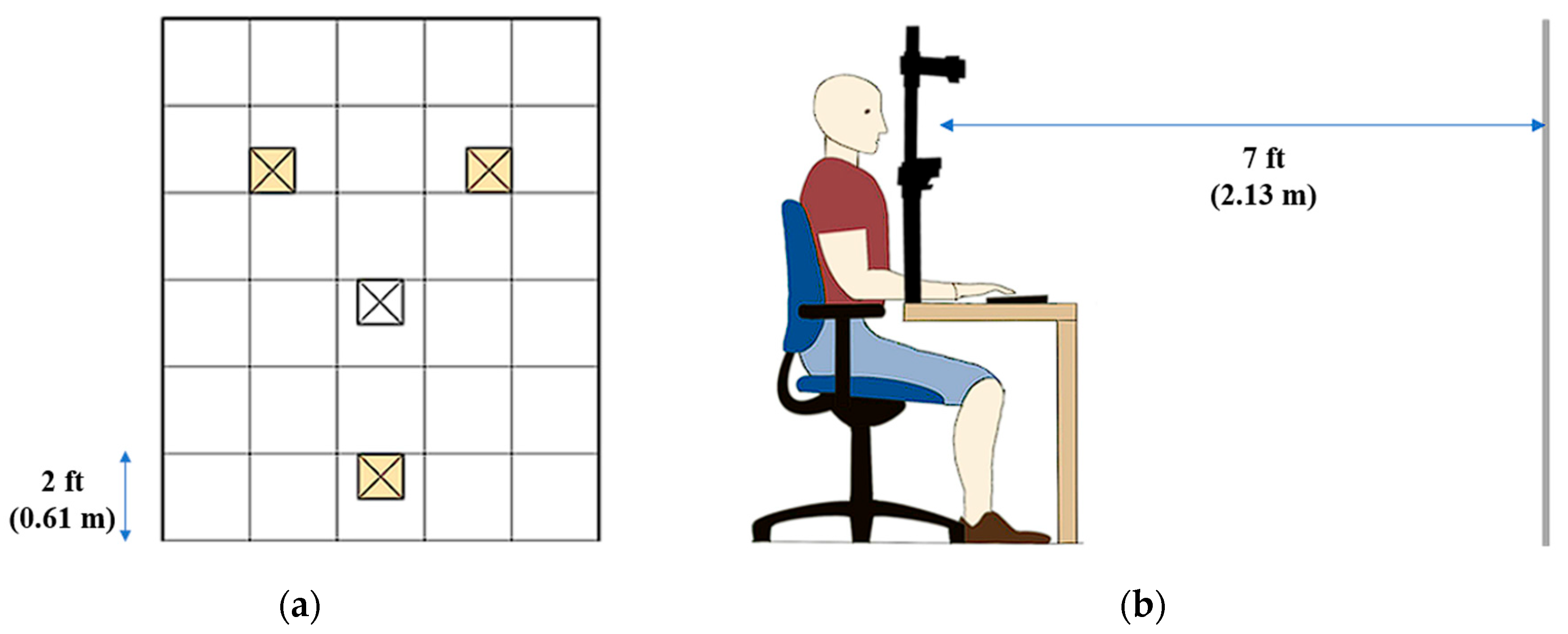

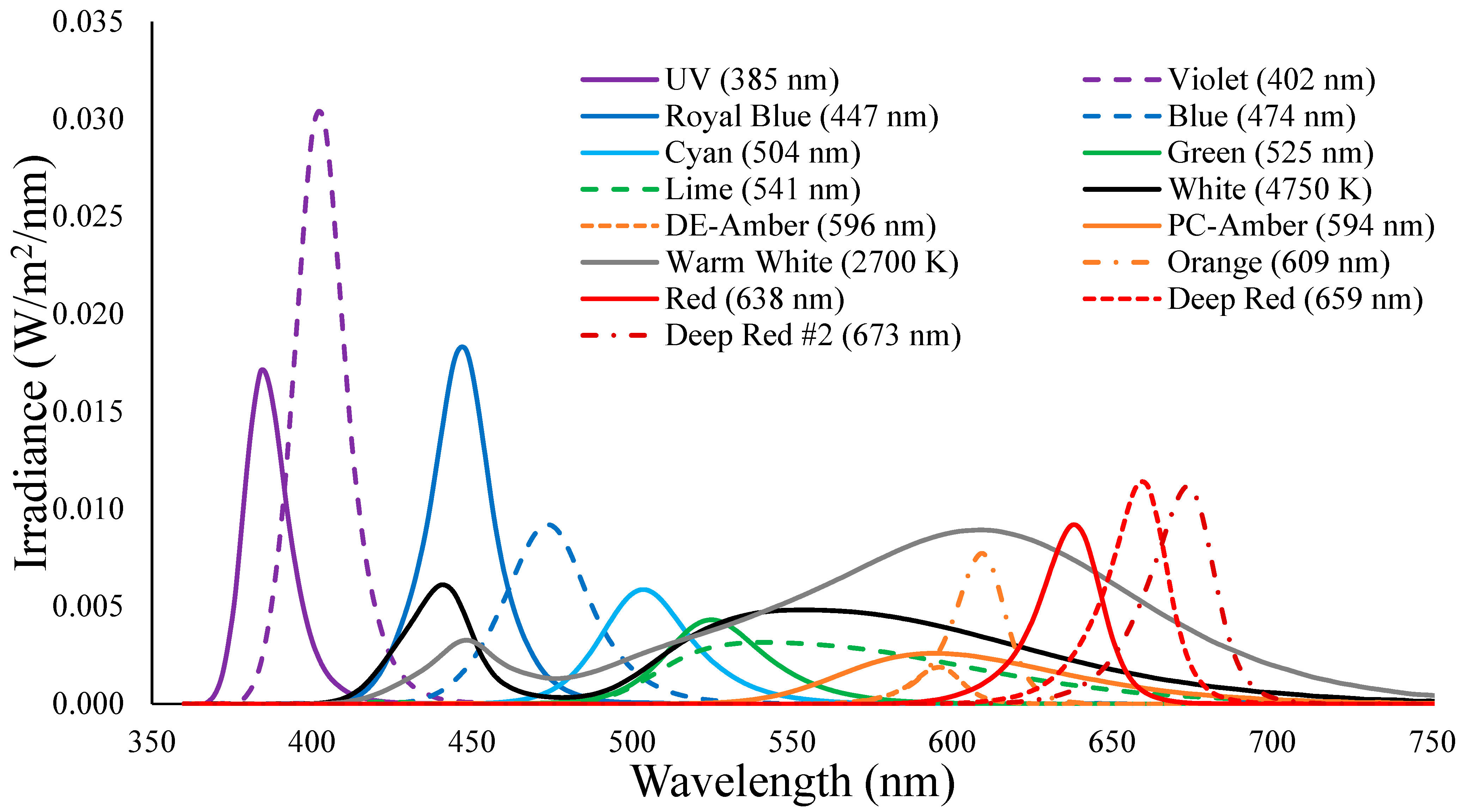

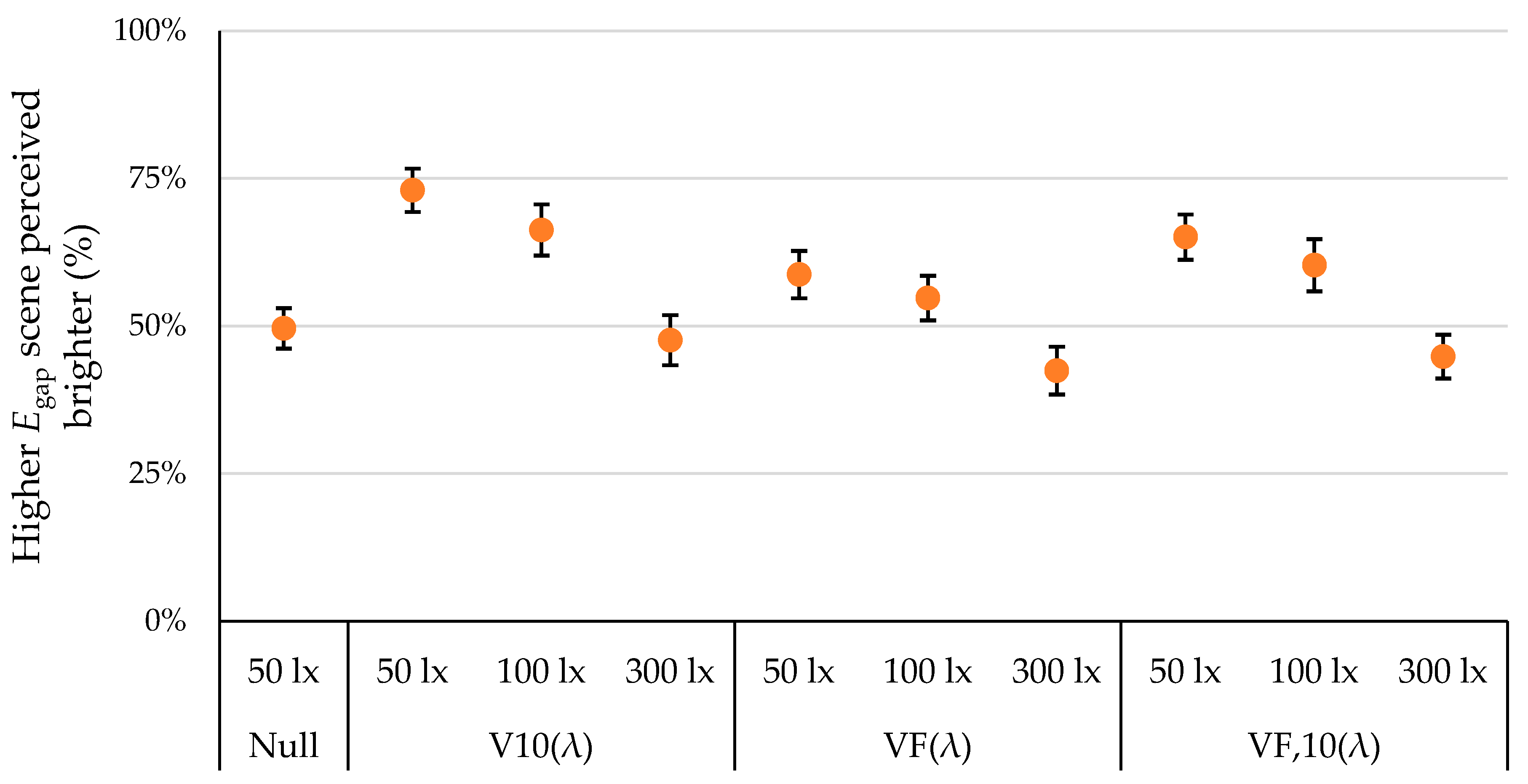
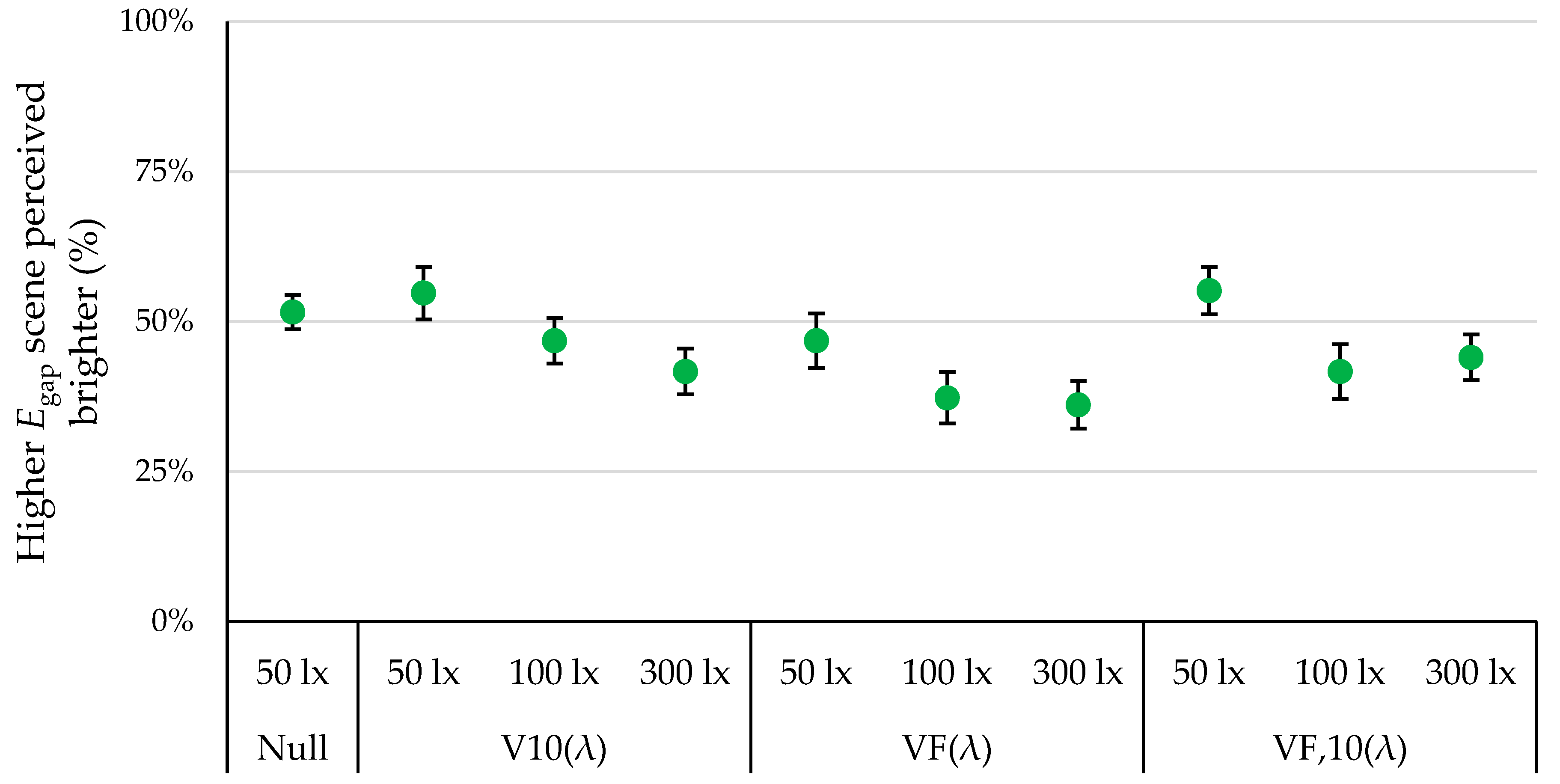
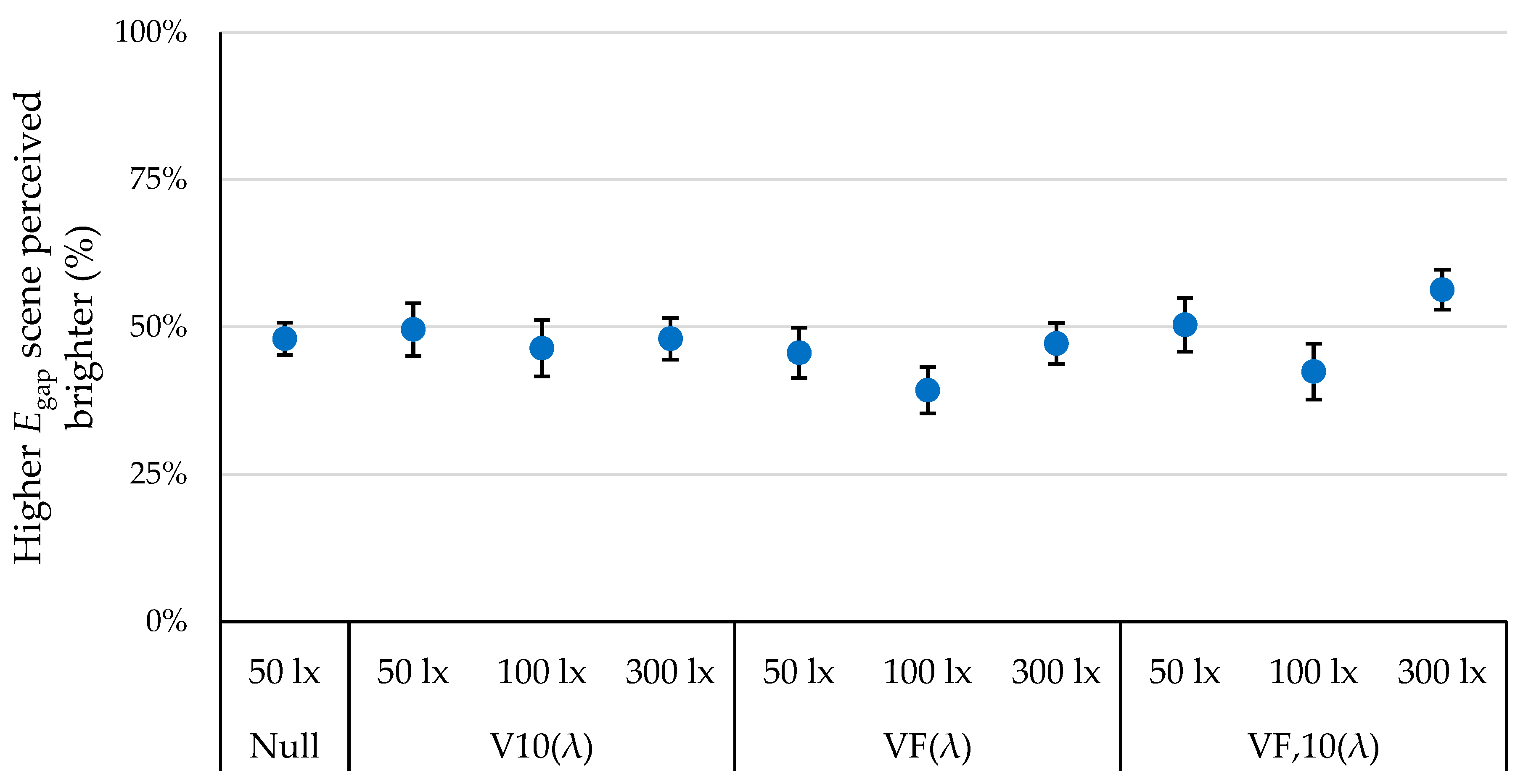
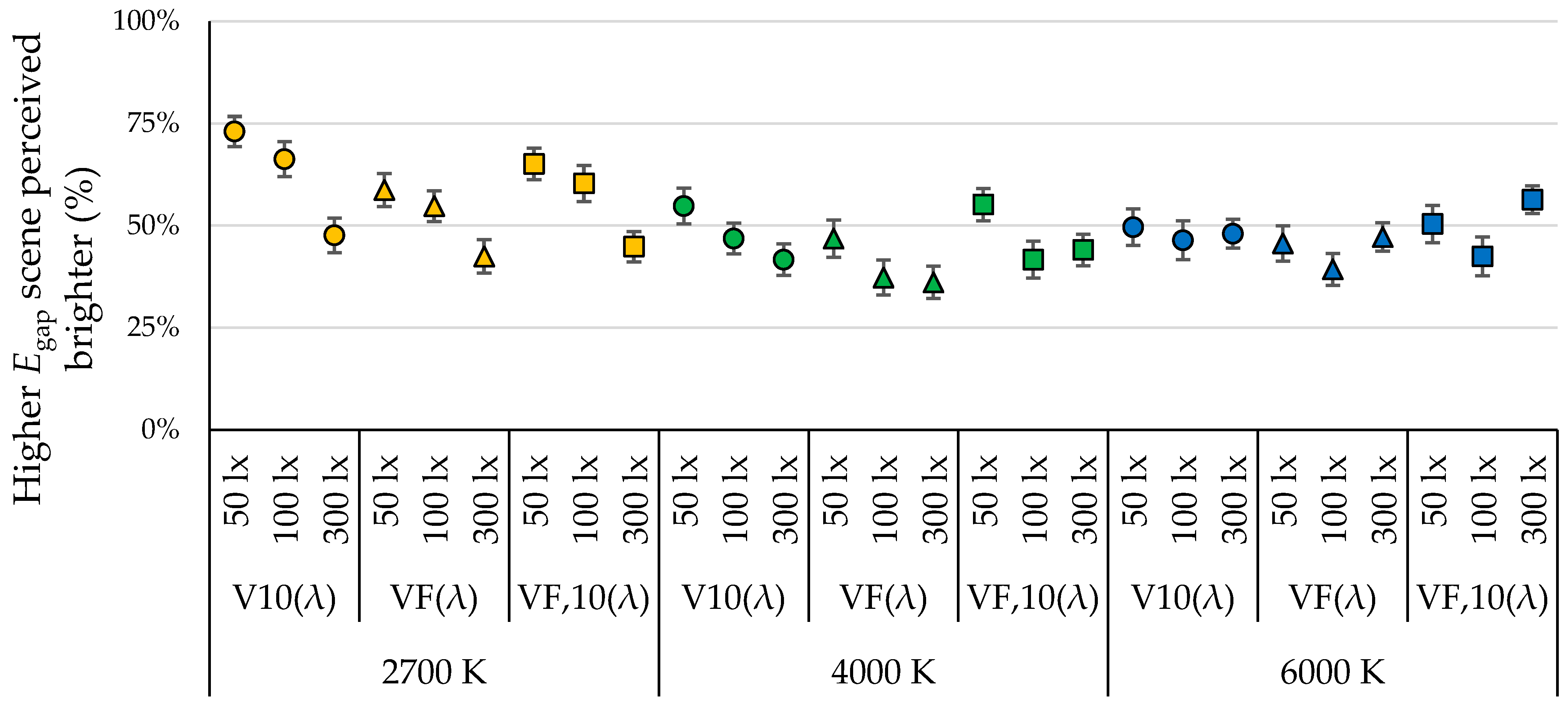
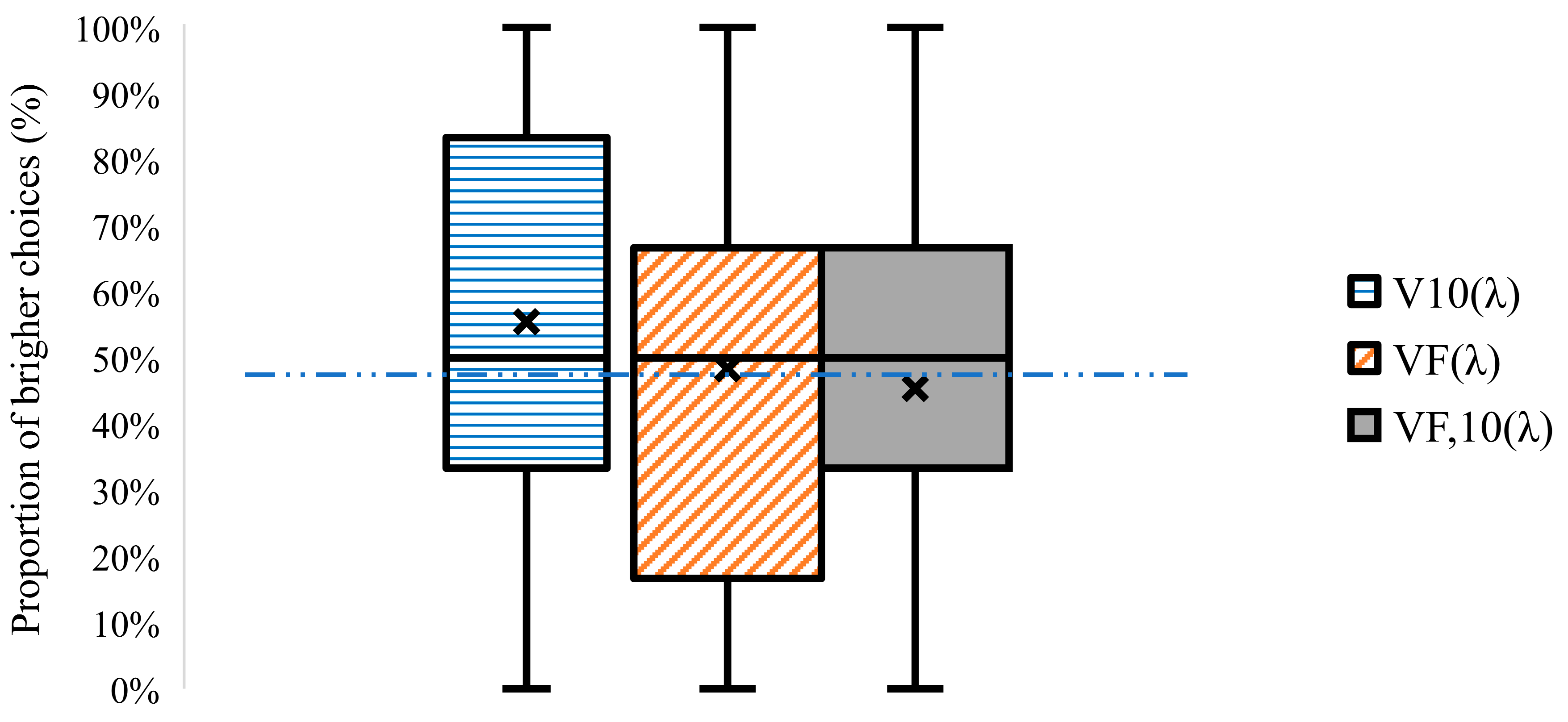
| Study | Participant | Protocol | Experimental Conditions | ||||||||
|---|---|---|---|---|---|---|---|---|---|---|---|
| n | Age | Training | Null | CCT Matched | Ev Matched | V(λ) Compared | Method | Apparatus | FOV | Objects | |
| [45] | 10 | 18–25 | - 1 | N/A 2 | N/A | N/A | No | Rating | Room | Full | No |
| [46] | 73 | 20–50 | - | No | No | N/A | Yes | Matching | Screen | 15° × 20° | No |
| [48] | 12 | 17–25 | - | No | No | No | No | 2AFC 3 | Room | Full | No |
| [60] | 33 | 18–30 | - | Yes | Yes | Yes | No | 2AFC | Room | Full | No |
| [61] | 28 | - | Yes | N/A | N/A | N/A | No | Rating | Room | Full | Yes |
| [65] | 40 | 20–63 | - | Yes | Yes | Yes | No | 2AFC | Booth | - | No |
| [66] | 42 | 19–56 | Yes | N/A | No | N/A | No | 2AFC | Room | Full | No |
| [67] | 12 | 22–53 | - | No | No | No | No | 2AFC | Booth | 100° | No |
| [68] | 12 | - | - | No | No | No | No | 2AFC | Booth | - | No |
| [69] | 12 | 18–36 | - | No | Yes | Yes | No | Rating | Booth | 34° | Yes |
| [70] | 10 | - | - | No | No | No | No | 2AFC | Booth | 18° | Yes |
| [71] | 10 | 22–33 | - | No | No | Yes | No | 2AFC | Booth | 100° | No |
| [72] | - | - | - | No | No | No | No | Rating | Booth | - | Yes |
| [73] | 48 | 20–25 | - | N/A | No | Yes | No | Rating | Room | Full | Yes |
| [74] | 15 | 19–55 | - | N/A | No | Yes | No | Rating | Room | Full | Yes |
| [75] | 29 | - | - | N/A | No | Yes | No | 2AFC | Room | Full | Yes |
| [76] | 56 | - | - | N/A | Yes | Yes | No | Rating | Room | Full | Yes |
| [77] | 30 | 18–36 | - | N/A | Yes | Yes | No | Rating | Booth | 80° | Yes |
| Target Tcp (K) | Target Ev,1924 (lx) | Scene (Pair) | Ev (lx) | Ev,F (lx) | Egap (lx) | ΔEgap (lx) | Measured Tcp (K) | u′ | v′ |
|---|---|---|---|---|---|---|---|---|---|
| 4000 K | 50 | A (1) | 49.97 | 53.94 | 3.97 | 1.69 | 4003.5 | 0.2251 | 0.5014 |
| B (1) | 49.97 | 52.25 | 2.28 | 4003.5 | 0.2253 | 0.5011 | |||
| 100 | A (2) | 99.99 | 107.06 | 7.07 | 2.70 | 3998.8 | 0.2251 | 0.5017 | |
| B (2) | 99.94 | 104.31 | 4.37 | 3999.5 | 0.2251 | 0.5016 | |||
| 300 | A (3) | 299.94 | 317.68 | 17.74 | 4.66 | 4005.8 | 0.2248 | 0.5019 | |
| B (3) | 300.07 | 313.87 | 13.08 | 4004.9 | 0.2250 | 0.5015 |
| Comparison | Mean Dif. | 95% CI of Diff. | Below Threshold | Summary | Adjusted p Value |
|---|---|---|---|---|---|
| V(λ) vs. V10(λ) | 34.88 | −6.140 to 75.90 | No | Ns | 0.115 |
| V(λ) vs. VF(λ) | 26.18 | −9.388 to 61.75 | No | Ns | 0.204 |
| V(λ) vs. VF,10(λ) | −0.0216 | −0.0411 to −0.0021 | Yes | * | 0.025 |
Disclaimer/Publisher’s Note: The statements, opinions and data contained in all publications are solely those of the individual author(s) and contributor(s) and not of MDPI and/or the editor(s). MDPI and/or the editor(s) disclaim responsibility for any injury to people or property resulting from any ideas, methods, instructions or products referred to in the content. |
© 2025 by the authors. Licensee MDPI, Basel, Switzerland. This article is an open access article distributed under the terms and conditions of the Creative Commons Attribution (CC BY) license (https://creativecommons.org/licenses/by/4.0/).
Share and Cite
Song, W.; Durmus, D. One Hundred Years of V(λ): Predicting Spatial Brightness Using Vertical Illuminance Derived from Photopic Luminous Efficiency Functions. Buildings 2025, 15, 3510. https://doi.org/10.3390/buildings15193510
Song W, Durmus D. One Hundred Years of V(λ): Predicting Spatial Brightness Using Vertical Illuminance Derived from Photopic Luminous Efficiency Functions. Buildings. 2025; 15(19):3510. https://doi.org/10.3390/buildings15193510
Chicago/Turabian StyleSong, Wangyang, and Dorukalp Durmus. 2025. "One Hundred Years of V(λ): Predicting Spatial Brightness Using Vertical Illuminance Derived from Photopic Luminous Efficiency Functions" Buildings 15, no. 19: 3510. https://doi.org/10.3390/buildings15193510
APA StyleSong, W., & Durmus, D. (2025). One Hundred Years of V(λ): Predicting Spatial Brightness Using Vertical Illuminance Derived from Photopic Luminous Efficiency Functions. Buildings, 15(19), 3510. https://doi.org/10.3390/buildings15193510







